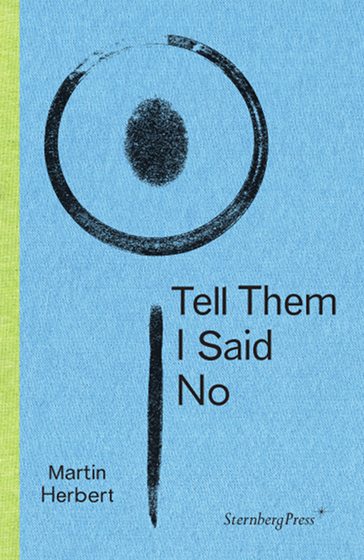
I've recently enjoyed and been enlightened by Martin Herbert's new collection of essays, Tell Them I Said No published by Sternberg Press. Herbert considers ten artists who have left the "art world" and how. I put that in scare quotes because some artists stop making work, while others stop showing it, and others refuse to perform as public figures discussing or representing their work.
It's a very thoughtful group of essays about a fascinating and challenging group of artists who, it turns out, are engaging with art and artistic practice entirely on their own terms. The artists are Agnes Martin, Albert York, Charlotte Posenenske, Stanley Brouwn, David Hammons, Lutz Bacher, Christopher D'Arcangelo, Laurie Parsons, Cady Noland, and Trisha Donnelly.
A couple of excerpts from Herbert's introduction:
As performed today, [self-detachment] pushes against the current in an epoch of celebrity worship and its related feedback loop, increasingly universal visibility and access. A big part of the artist's role now, in a massively professionalized art world, is showing up to self-market, being present. On all channels, ideally: see how, aside from all the photo opportunities, far-from-digital-native figures take to social media or splash themselves when possible across magazines (which grander galleries now produce themselves) or collaborate with fashion designers, all gates open.Each case Herbert examines is particular; he does not try to force artists' experiences and choices into an over-arching historical analysis. But as I found myself nodding along in recognition and admiration for these artists, I came to feel a case being made against the structures of the market- and celebrity-centered art world we're soaking in....
In such a context of hectic short-termism and multiple types of oversharing, some kind of voluntary retreat, some respect for the Joycean triumvirate of silence, exile, and cunning, might constitute a vanguard, if a difficult and apparently suicidal one to countenance today since it seemingly requires earning the right to leave.
...
None of this, meanwhile, has transpired in a steady-state art world. Rather, the urge to pull back, where felt, echoes changing conditions over decades, from the swing toward dematerialization and its intersection with critique, to art's transmogrification into a backcloth for the power plays of the prosperous.
This multi-faceted questioning reminded me of another paradigmatic challenge, posed by Helen Molesworth in the Dec. 2016 issue of Artforum. Molesworth asks why shock, countering shock with shock, and a strategy of épater le bourgeoisie persists as the dominant mode of modernism and the avant-garde:
Must meaning be predicated on shock? Why was a cut or a break always required for something to be historically serious or significant? Why couldn't continuity or gentleness, even, be imagined as a hermeneutic of radicality? As someone with a nascent interest in domesticity and the quotidian, I felt that shock didn't help me understand much of anything.Molesworth goes on to discuss powerful examples of engagement, listening, connection and self-reflection as alternatives to the received models of attention-grabbing spectacle and an ever-intensifying cycle of shock and desensitization. In a similar way, while the artists Herbert discusses don't show a singular path out of the current hall of mirrors, they remind us of the overlooked potential of engaging art with questioning, silence, and refusal.
Who could refuse to buy Tell Them I Said No at Amazon for like $24? [amazon]












